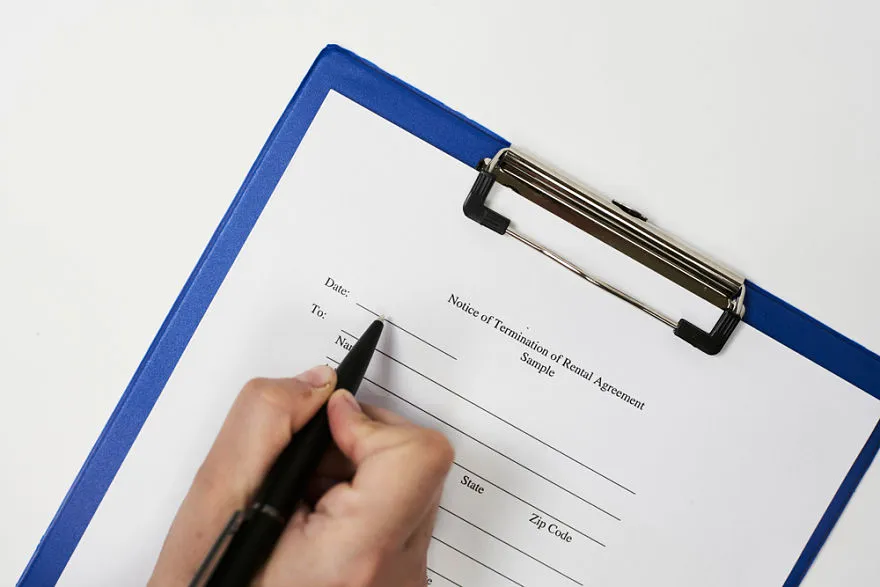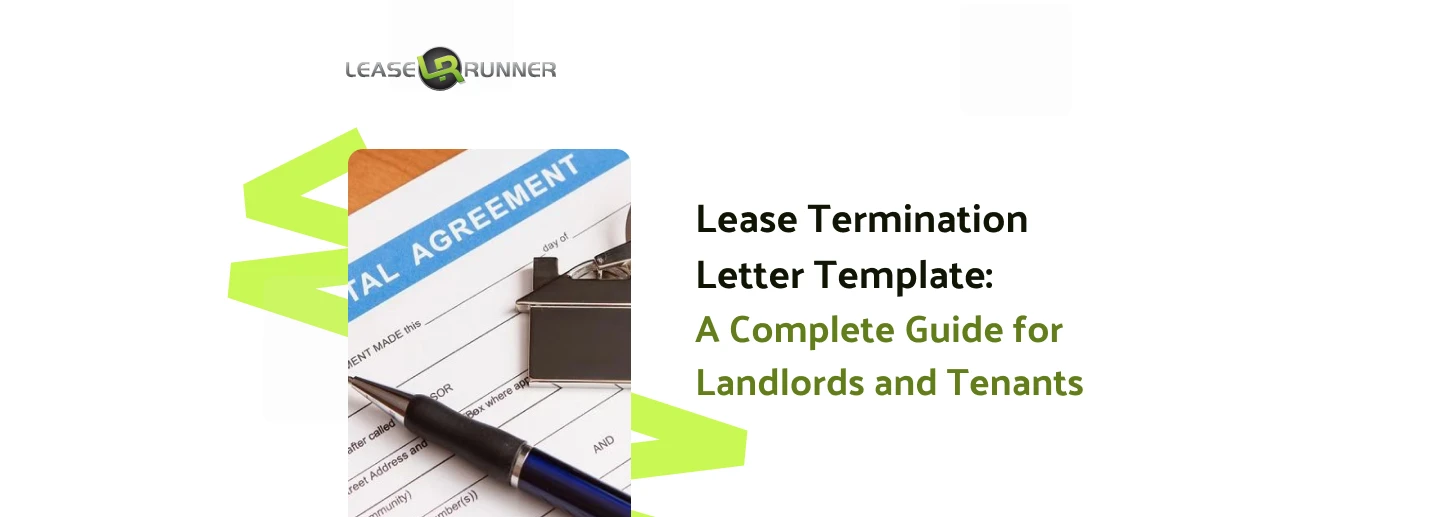No one likes last-minute surprises when it comes to lease agreements. A properly written lease termination letter sets clear expectations, avoids misunderstandings, and ensures a smooth transition. In this article, we will walk you through every step, covering notice requirements, legal considerations, and a free lease termination letter template to simplify the process.
What Is a Lease Termination Letter?

A lease termination letter is a formal document that notifies a landlord or tenant that a lease agreement is coming to an end. It serves as an official record of the decision to terminate the lease and helps prevent misunderstandings.
Without a clear, written notice, ending a lease could lead to disputes over unpaid rent, security deposits, or property damage. A letter to terminate a lease agreement keeps everything professional and legally sound by outlining the move-out date, final responsibilities, and any next steps.
What Should Be Included In A Lease Termination Letter?
A well-written letter to terminate a lease agreement gives both tenant and landlord clarity and helps avoid future disputes. Always include:
- Date of the Letter: Note the date the letter was written so you have a clear record.
- Names and Contact Information: Include both the landlord's and tenant's full name and address to match the rental documents.
- Property Address: Clearly identify the actual rental property to avoid confusion as you would in a typical lease termination letter.
- Termination Date: Exact date that the lease will terminate.
- Reason for Termination: Give a brief explanation for wanting to end the lease; having valid grounds will help with approval.
- Notice Period Compliance: Note that you are complying with the allocated notice time, an important element of legal notice to terminate a lease.
- Move-Out Instructions: Remind them of cleaning, returning keys, and final inspection to facilitate a smooth transition as outlined in most end-of-lease letters to the tenant from the landlord.
- Security Deposit Details: Ask how and when the deposit will be returned.
- Forwarding Address Request: Provide a new address for potential mail or deposit returns.
If you are looking for suggestions on how to write a letter to terminate a lease or a sample letter to cancel a lease agreement, you may want to review a free lease termination letter template prior to sending your notice.
Different Types of Lease Termination Letters
Lease termination letters come in many forms, depending on who sends them and why the lease ends. Choosing the right letter helps tenants and landlords avoid disputes and follow the law. Here are the main types with clear definitions, purposes, key parts, and when to use each.
1. Lease Termination Letter by Tenant
- Definition: A letter from the tenant to end the lease.
- Purpose: To notify the landlord clearly and document your intent.
- Key Components: Date, tenant and landlord names, property address, termination date, reason for leaving, signature.
- When to Use: When you plan to move out at the lease end or want to start the process. This type is a common letter to terminate a lease agreement or a notice to terminate a lease.
2. Lease Termination Letter by Landlord (for Fixed-Term Lease)
- Definition: A landlord’s letter informing tenants that the lease won’t renew.
- Purpose: To give tenants time to plan their move and avoid last-minute issues.
- Key Components: Lease end date, property address, move-out instructions, and deposit info.
- When to Use: To end a fixed-term lease naturally, as seen in an end-of-lease letter to the tenant from the landlord.
3. Lease Termination Letter for Early Termination (by Tenant)
- Definition: A letter where tenants request an early lease ending.
- Purpose: To provide written notice and reduce penalties.
- Key Components: Lease reference, termination reason (e.g., job move), proposed final date, contact details.
- When to Use: For urgent moves or valid reasons; an example of a sample letter to cancel a lease agreement.
4. Lease Termination Letter by Landlord (for Early Termination)
- Definition: A notice from the landlord to end a lease early, often for major repairs or property sale.
- Purpose: To comply with local laws, protect property interests, and provide tenants time to relocate.
- Key Components: Legal clause invoked, property address, termination date, required notice period, and landlord contact.
- When to Use: When landlords have valid contractual reasons for ending a lease, combined with compliance with local notice rules; see this notice period resource.
5. Lease Termination Letter for Non-Renewal (by Tenant)
- Definition: A written notification from the tenant declining to renew the lease.
- Purpose: To prevent automatic lease extensions and set expectations for move-out.
- Key Components: Lease end date, addresses, tenant signature, and instructions for moving out.
- When to Use: When you plan to move after the lease is up, making it a classic lease termination example included in many free lease termination agreement template forms.
6. Lease Termination Letter Due to Habitability Issues (by Tenant)
- Definition: A letter explaining why unlivable conditions mean the tenant must leave.
- Purpose: To document legal grounds for breaking a lease, often without penalties.
- Key Components: Description of issues, copies of previous repair requests, lease clause references, and official move-out date.
- When to Use: When health or safety problems persist, and the landlord fails to remedy the situation.
7. Lease Termination Letter for Domestic Violence (by Tenant)
- Definition: A request to end the lease early due to incidents of domestic violence.
- Purpose: To safeguard the tenant and exercise state-protected rights.
- Key Components: Summary of situation, supporting documents (restraining order or police report), and requested move-out date.
- When to Use: When escaping a dangerous environment with legal protection backing your decision.
8. Lease Termination Letter for Non-Compliance (by Landlord)
- Definition: A Formal notice from the landlord due to tenant violations, like unpaid rent or property damage.
- Purpose: To demand compliance or removal, as required by local laws.
- Key Components: Description of lease breach, cure date (if allowed), and eviction process steps.
- When to Use: When tenants violate terms; consult this eviction notice guide for correct legal steps.
9. Lease Termination Letter for Eviction (by Landlord)
- Definition: An official eviction notice detailing the reasons and steps for tenant removal.
- Purpose: To meet legal requirements and provide the tenant with an organized timeframe to vacate.
- Key Components: Legal basis, property address, deadlines, and necessary disclosures.
- When to Use: To formally evict, always following local eviction laws to avoid disputes.
10. Lease Termination Letter for Mutual Agreement
- Definition: A jointly signed agreement where landlord and tenant both choose to end the lease.
- Purpose: To document consent and avoid penalties or disputes later.
- Key Components: Contract details, reason for ending, move-out date, signatures of both parties.
- When to Use: When both sides agree, ending the lease benefits everyone, making the process smooth and conflict-free—a common and ideal notice of termination for a tenant.
When Should You Use a Lease Termination Letter?
A lease termination letter should be used anytime a lease ends, regardless of the circumstances.
- End Of Lease Letter To Tenant From Landlord: If a tenant or landlord does not wish to renew a lease, a letter to terminate the lease agreement officially confirms the decision and provides the required notice.
- Lease Violations: If a tenant repeatedly breaks lease terms (e.g., not paying rent, causing property damage, or violating occupancy rules), a landlord may use a termination letter to initiate eviction.
- Property Sale or Major Renovations: A landlord who plans to sell the rental property or conduct extensive renovations may need to terminate the lease.
- Ending a Month-to-Month Lease: In month-to-month agreements, either party can end the lease by providing written notice to terminate the lease, usually 30 to 60 days in advance.
Without a letter to terminate the lease agreement, miscommunication can lead to unwanted surprises (like a tenant assuming they can stay longer or a landlord withholding a security deposit).
How to Write a Lease Termination Letter in 5 Easy Steps (For Landlords)?

Writing a formal lease termination letter might seem tricky at first. However, breaking it down into clear, simple steps makes the process straightforward.
Whether you need a letter to terminate a lease agreement or want to create an official notice to terminate a lease, following these five steps ensures your letter is professional and legally effective.
1. Start with Landlord and Tenant Information
When you start your letter, state the full names and contact information for both the landlord and tenant. If you include the rental property address, there will be no confusion about which lease is ending.
For example, a lease termination letter template will almost always have this information in the beginning to retain clear records and avoid any mistakes later on.
2. State the Purpose of the Letter
Next, get straight to the point by stating you are providing the purpose of this letter. You have to be clear that this is a formal written notice that you are ending a lease. You also need to be clear that the landlord is terminating the lease.
It is better to be direct and clear to avoid any misinterpretation. if you wish to use your lease agreement or refer to the section of your lease agreement about ending the lease using some type of notice, you can mention that if you wish to.
3. Specify Termination Date and Notice Period
You need to state clearly when the end of the lease will be. Provide the exact termination date. You also need to conclude the notice period you are giving, required by law or your obligation (30-day notice, 60-day notice, or 90-day notice). Many leases will tell you what those dates are, so you should investigate your lease agreement prior to writing.
Providing these two details meets the format for standard end-of-lease letters issued to tenants from a landlord.
4. Explain Reason for Termination (If Applicable)
If the lease ends early or for a specific reason, briefly explain why. Common causes include property sale, renovations, or tenant violations. Keeping the tone professional and factual helps maintain goodwill.
If you need guidance, look at a free lease termination agreement template for examples of how to phrase reasons clearly.
5. Include Instructions and Contact Information
Finally, list everything you believe the tenant must do before moving out. Including cleaning, returning the keys, scheduling the final inspection, etc. Then include your contact information if the tenant has questions.
An uncomplicated close will avert any disputes and establish clarity in their responsibilities, and just as with a sample cancellation of lease agreement letter, such as the cancellation letter template.
By following these steps, landlords can successfully generate a clear letter terminating the lease that is not only perfect for their situation but also creates a solid lease termination agreement.
If you are not familiar with this process, looking at a lease termination example or sample letters for writing a letter to cancel a lease is certain to make life easier.
How to Write a Lease Termination Letter (For Tenants)?
As a tenant, a lease termination letter is a formal way to terminate the rental agreement you currently have, and it will help clarify your intentions. If you want a sample letter to terminate a lease agreement, or need to know how to write a letter to terminate a lease, you'll find those steps laid out below to help you in the process.

1. Start With Your Contact Information and Date
At the beginning of the letter, list your name, current address, and contact information. Make sure to include the date you are writing the letter. The letter will be clearer than if it were hand-delivered, and hopefully, your landlord can keep it all neatly organized.
2. Add Landlord's Name and Address
Next, add your landlord's name and address. Paying proper respect to the person receiving the notice will make sure they know who you are trying to communicate with and not have an issue that will confuse your notice.
3. Include Your Intention To Terminate the Lease
Now, you want to be direct and state your intention to terminate the lease. Be direct with statements like, "I am writing to inform you of my intention to terminate the lease agreement." This portion of the notice of termination, as a tenant, is the part that must happen and lets the landlord know where you are coming from.
4. Identify the Lease and Move Out Date
Provide the address of your rental unit and the date that you are going to move out. Make sure that your move-out date is in line with any notice provisions required by your lease. For example: "My lease for the unit located at [address] will end on [date]."
5. Reference Lease Clause or Laws Regarding Notice Provisions
Reference the lease clause or local laws regarding the notice provisions to show that you are complying with the provisions. This may prevent any disputes later on.
6. Optional Reason for Terminating
You can also simply explain your reason for terminating, job relocation, personal reasons, and so on, though this is not always necessary. This provides context and may benefit you if your landlord is willing to provide a reference.
If you need to break your lease for any reason, you can learn more here: how to get out of a lease early. This should be kept to a brief, professional statement.
7. Request confirmation
You should request a response from your landlord to confirm receipt of your notice and acceptance of your move-out date. This helps you maintain a documented proof of record of communication.
8. Provide Forwarding Address and Contact Information
Finally, give your forwarding address, phone number, or email. This ensures you can receive your security deposit and important mail after moving.
Following these steps creates a clear, professional letter. If you want more examples or tips, a guide on how to write a letter to remove someone from a lease or other templates can help. Using the right format or lease termination letter template makes the lease termination process easier and legally sound for everyone.
Lease Termination Letter Template
Writing a lease termination letter from scratch can feel overwhelming, but you don’t have to start from zero. A well-crafted lease termination letter template saves time, ensures all necessary details are included, and keeps the process professional.
Below, you'll find a free lease termination agreement template / an example of a lease termination letter that works for both landlords and tenants. Simply fill in the details, customize it as needed, and send it out with confidence.
Tip: Always double-check your lease agreement and state laws before sending the letter.
5 Mistakes to Avoid When Writing a Lease Termination Letter

Avoid these common errors to ensure a smooth and stress-free lease termination process:
Writing a lease termination letter takes some caution in order to prevent issues. Here are five mistakes that can lead to confusion or delays.
1. First, many people forget to give proper notice. Most states provide for a notice/termination period of between 30 and 60 days before terminating the lease.
If you do not provide the proper notice, you may incur penalties or other legal issues. Be sure to check your lease and local laws to see what the exact time period for notice is.
2. Second, when people do provide notice and corresponding letters, they forget to simply state the move-out date or reason for terminating the lease, along with the next steps.
Saying you are leaving "soon" may make it difficult for either a landlord or tenant to prepare accordingly. Therefore, be sure to clearly state information in your letter.
3. Third, using vague and casual wording makes your letter ineffective. Your letter should be courteous, but should be precise and to the point, in stating exactly what you mean.
4. Fourth, tenants will sometimes fail to ask how their security deposit return will happen, and landlords will not explain any deductions they are going to take from the security deposit.
To ensure that there is no misunderstanding regarding security deposit return, tenants should ask about the return of their deposit, while landlords should clarify any deductions.
5. Lastly, some landlords forget to save a copy of the lease termination letter, which may cause several problems in the future. Therefore, always keep a copy of your lease termination letter. Make sure you have proof of sending a copy of the letter, should you need it down the line.
State-Specific Rules to Keep in Mind for Lease Termination
Lease termination laws aren’t the same everywhere.
States set their own landlord-tenant laws based on factors like housing demand, tenant rights movements, and local rental markets. While some states prioritize tenant protections, others offer more flexibility to landlords.
- Virginia: Landlords must give at least 30 days' notice for month-to-month leases. However, tenants only need to provide 15 days' notice if they wish to leave.
- California: If a tenant has lived in the unit for more than a year, landlords must provide 60 days' notice to terminate a lease. For shorter stays, 30 days is required. Additionally, rent control laws in some cities may affect termination rights.
- New York: Notice periods depend on the length of the tenancy. For instance, tenants who have lived in the unit less than a year will require 30 days’ notice to terminate the lease.
Therefore, always check your state’s official housing authority website or consult a local attorney. You can use LeaseRunner’s lease agreement templates for state-compliant documents and stress-free lease terminations.
This table below offers a snapshot of tenant and landlord notice requirements for lease termination across multiple states, but always verify your local rules as they may change.
What Happens After a Lease Termination Letter Is Sent?
Sending a lease termination letter is just the beginning of the move-out process. Here’s what happens after:
Timeline for Vacating
Once the letter is sent, the tenant has until the termination date to move out. It depends on:
- The required notice period (typically 30 to 60 days)
- Any agreed-upon extensions between the landlord and tenant
- Special circumstances (such as lease buyout agreements)
Both parties should use this time to prepare for a smooth transition.
Final inspection and checklist
Before moving out, the landlord and tenant should schedule a final walkthrough to assess the property's condition. Tenants should:
- Clean the unit thoroughly
- Repair any minor damage (e.g., nail holes, scuff marks)
- Remove all personal belongings
- Return all keys, garage remotes, and access cards
Security Deposit Return Process
Landlords typically have 14 to 30 days (depending on state laws) to return the security deposit or provide an itemized list of deductions for damages. Tenants should provide a forwarding address to ensure smooth deposit processing.
Updating Address & Utility Shut-Off
Before leaving, tenants should:
- Update their address with the post office, banks, and subscription services.
- Schedule utility shut-offs (electricity, gas, water, internet) to avoid extra charges.
- Notify their employer and other important contacts of their new address.
Final Thoughts
With the right lease termination letter template, both landlords and tenants can handle the process professionally and with confidence. A clear and well-structured letter helps set expectations, ensures all legal requirements are met, and maintains positive relationships between both parties. Take the time to personalize your letter for the best results!
FAQs
Q1: How much notice is required for lease termination?
Notice periods vary based on state laws and lease agreements, but typically, tenants must provide 30 to 60 days’ notice before moving out. Landlords usually need to follow the same timeline unless the lease states otherwise.
Q2: Can a lease termination letter be sent via email?
Yes, but it depends on the lease terms and local laws. Some jurisdictions require a written notice to end a lease and a signed letter delivered in person or via certified mail to ensure legal validity.
Q3: Can a landlord refuse a lease termination request?
If the lease includes an early termination clause, tenants may be required to meet specific conditions (such as paying a fee). Otherwise, if proper notice is given for a fixed-term lease ending, the landlord cannot refuse.
Q4. How to write a letter to terminate a lease?
When writing a lease termination letter, the first thing to do is put in your own contact information and the date. Then, include the landlord's name and address. Next, it is time to state that you intend to terminate the lease and identify the move-out date.
Reference the lease, or specify that the notice you are providing is in accordance with the law. Your lease may state a 30-day or 60-day notice in advance. You may want to add, as an option, an explanation of your reason for moving, such as you got a new job in another city.
Finally, make a request for a confirmation of receipt, and provide an address for forwarding.
Maintain a clear and polite tone, and act professionally. Using examples of a letter to cancel the lease agreement, or a lease termination sample, can help you develop your formatting.
Q5. How to write a letter to remove someone from a lease?
Write a letter indicating that you want a certain tenant removed from the lease agreement. You want to include the names of all parties involved and the full rental address. Then again, state clearly your request for them to be removed, and the date you want the request to be effective from.
This letter should be signed by the landlord and all of the other tenants that remain, to confirm consent for this change to be made.
Keeping a copy of the letter is good practice, if anything ever becomes a question of confusion in the future. If you are not entirely certain of the format and would like an official format, you can search for how to write a letter to remove someone from a lease.
Q6. What is the most common way to end a lease?
The most common way to end a lease is to simply reach the end date of the lease, followed by either renewing the lease or moving out. Generally, tenants give a written notice of termination to the landlord so they know the tenant will not renew the lease.
The termination can also be by mutual agreement between the parties. As long as the parties communicate about their intentions and document those conversations, it can be a minor process.
Q7. What is the tenant's notice of termination?
A tenant's notice of termination is a written document that is given to the landlord stating that the tenant intends to terminate the lease. The notice will state what the intended moving date is and will comply with the notice period required.
A notice of termination is a formal letter that a tenant can use to protect their rights as a tenant and for the landlord to prepare for new tenants. Even though a letter to terminate a lease is straightforward, knowing how to write one correctly is important.







